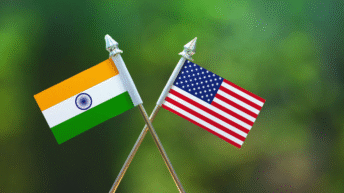
When India became Independent on 15 August 1947, the vast majority of princely states had signed the Instrument of Accession with India. Three states however had yet to do so—the princely states of Junagadh, Hyderabad and Kashmir. Junagadh, a princely state in Gujarat with a near total Hindu majority had a Muslim ruler. A plebiscite conducted in February 1948 to determine the status of the state was almost unanimous, with over 99.95 percent of the electorate voting for accession to India. In Hyderabad, the Nizam, Mir Osman Ali Khan ruled over a largely Hindu population. The atrocities heaped on the Hindu population forced the Indian government to use the military to liberate the state. This was achieved in a swift operation codenamed Operation Polo, which began on 13 September 1948 and concluded five days later on 18 September with the surrender of the Nizam’s forces.
The situation in J&K was however more complex. The border state had two large population groups, both Hindus and Muslims with the latter having a larger majority. Before the ruler, Maharaja Hari Singh could take a view on the accession of his state, armed Pakistani raiders, led by Pakistani army officers, invaded Kashmir in October 1947, barely two months after Independence. The Maharaja lacked the capacity to defend his kingdom from these attacks. There were just three battalions available for the defence of the Kashmir division, of which one battalion was at Srinagar, one at Domel and a third at Gilgit Agency. Of the four battalions south of Pir Panjal range, one each was located at Poonch, Rawalkot, Naushera and Mirpur.[1] Some of these were mixed battalions with both Dogra and Muslim troops. Poor communications and the vast spread of the area meant that each battalion was really fighting an independent battle and could not depend on support from anyone.
The Pakistani plan to take the state of J&K by force was codenamed “Operation Gulmarg,” under the command of Brig (later Major General) Akbar Khan, a serving officer of the Pakistan army.[2] A force of 7,500 tribals mixed with Pakistan army personnel began the offensive on 22 October, which was characterised by murder, loot and rape. The Muslim companies of the Maharaja’s forces deserted their posts and joined the raiders, after shamefully killing their Dogra colleagues. By 26 October, the raiders were on the outskirts of Srinagar, when the Maharaja requested India’s help and signed the Instrument of Accession. The next day, the first lot of troops from the Indian Army were flown into Srinagar and the raiders were halted on the outskirts of the city. Thereafter, they were pushed back till a ceasefire was declared on 31 December 1948. This was the first defining moment in the post-independence history of the state. At the time of the Ceasefire, Pakistan was in possession of about one-third of the state of J&K, to include the areas of Gilgit-Baltistan and Mirpur-Muzaffarabad. This line has seen minor modifications post the 1971 war with Pakistan, where it came to be known as the Line of Control. But the fact that the raiders were stopped and pushed back despite unimaginable odds is a credit to the Indian Infantry, which since then, celebrates 27 October as Infantry Day.
The second defining moment in the history of the state came with the onset of the radicalisation of Kashmiri Muslims. The process, which started in the mid-sixties, had, by the mid-seventies, picked up the pace, eventually culminating in the genocide of the minority Hindu population in Kashmir in January 1990. This was perhaps the saddest moment in the history of the state, where the indigenous Hindu population which had been living here for over five millennia were forced to flee their homeland and seek refuge in other parts of India. The much-vaunted “Kashmiriyat” – a blend of Hindu and Muslim traditions, was brutally killed at the altar of Islamic radicalism. The Indian Army was called in to restore order in the state and while the outward manifestation of peace has been restored, the challenge of eliminating terrorism in full still remains, largely because terrorism is fuelled and funnelled from across the border by Pakistan. The Indian Army hence remains deployed in the region, carrying out counter-terrorism operations.
We are now in the midst of the third defining moment in the state, post-independence. On 5 August 2019, the Special Status given to the state was withdrawn by an Act of Parliament, passed by both the Houses. With the revocation, the state was also bifurcated into two Union Territories (UT), The UT of J&K and the UT of Ladakh, the former with a legislature and the latter without. This has perhaps been the most revolutionary piece of legislation in post-Independence history, designed to bring peace and normalcy to the state.
Since the revocation, the state has seen a downward spiral of violence, but it will take some more time for peace to return fully to the UT. Importantly, incidents of stone pelting, hartals and attending the funeral of slain terrorists, which was a frequent occurrence since 1990, are now a thing of the past. The linkages which the Hurriyat Conference had with Pakistan have been considerably weakened as has the ability of this organisation to stoke violence in the UT. Abrogation of the Special Status given to the former state of J&K is however not a panacea for peace. Many challenges still lie ahead for restoration of total normalcy. But without the revocation, peace in the region would have been but a chimera. There is no magic wand to negate the effects of over four decades of radicalisation, wherein even the state’s administrative machinery had been corroded. But the fact that the process has begun in real earnest brings forth, for the first time, the hope of total peace in the region. That will mark the beginning of the fourth phase of the defining moments in the history of J&K. Hopefully, this will come about by 2024.
[1] Rohit Singh, Operations in Jammu and Kashmir, 1947-48, Scholar Warrior, Autumn 2012, available at https://archive.claws.in/images/journals_doc/SW%20i-10.10.2012.150-178.pdf
[2] Details of Operation Gulmarg have been given by Maj Gen Akbar Khan in his book, Raiders in Kashmir.






Add comment